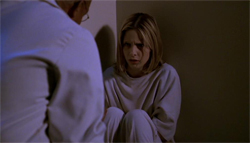 Buffy the Vampire Slayer is a lot more complex than the title of the show suggests, and after six years, the heroine of this series has collected a lot of baggage, emotional and otherwise.
Buffy the Vampire Slayer is a lot more complex than the title of the show suggests, and after six years, the heroine of this series has collected a lot of baggage, emotional and otherwise.
No wonder she’s hallucinating.
But while many of us create fantasies to deal with stress in our day to day lives, Buffy (Sarah Michelle Gellar) has been living in a fantasy world with some harsh realities – a soul mate who can’t be with her for fear of losing his soul and becoming an evil demon; the death of her mother at the hands of an aneurism, not monsters she can fight; and a destiny that will see her never have a normal life because she’s The Chosen One and lives on a hellmouth.
Or could she have a normal life? And what is normal?
In “Normal Again,” a run-in with a demon has Buffy jumping from two frames of mind thanks to the creature’s nasty venom. In her hallucination, she’s in a mental institution, and she’s been there for six years. Her parents are still together, and Buffy’s having a moment of lucidity, according to the Doctor. There is a chance, he says, that she could make a full recovery from her multi-layered schizophrenia.
Meanwhile, back in Sunnydale, Buffy’s in and out and her friends take it upon themselves to capture the demon in question and harness the antidote. All in all, it turns out to be a simple task, even if Willow can’t make use of magic do cook up the cure.
The question is, does Buffy really want to get well?
Her moments of lucidity at the institution are becoming more prolonged, and in Sunnydale, Buffy dumps the antidote in the garbage, and no one’s the wiser.
The Doctor tells Buffy that she must take apart the traps that keep her in imaginary world. Those traps are her friends, which she thinks are sacred, says the Doctor, but she must give them up.
Buffy wants to be healthy, she tells her parents. What does she have to do?
Back in Sunnydale, Buffy is systematically dealing with Willow, Xander and her sister Dawn. She captures and assembles them in the basement with the nasty monster that started this mental roller coaster in the first place.
At this point, all bets are off – Buffy’s parents are encouraging her to shut down her imaginary world, and that means setting the demon loose on her friends, who are still tied up. Buffy’s almost catatonic as the monster pummels them.
In the institution, it’s clear Buffy’s struggling to destroy her life in Sunnydale, despite the desperate pleas of her friends, and by now, it starts to become conceivable that Buffy’s life for the past six years could very well be a sham, but as the episode counts down to its closing moments, Tara rushes in and turns the tide in favour of the Sunnydale Scooby gang.
It’s also enough to snap Buffy back to reality and kick some demon ass, albeit after a tearful goodbye to her parents at the institution. All’s well that ends well, right?
Nope.
As much as Buffy has chosen to stay in Sunnydale and admitted to her friends that she did not take the antidote, it’s unclear why she made the choice she did.
Did Buffy choose Sunnydale because she knew it was reality? Or is she giving into the fantasy? Was she willing to believe that the institution would better than her life as the Slayer?
The final scene of the episode does nothing to clarify this, and one could dismiss it as being hoaky, or take it for a telling sign of things to come. Utlimately, Buffy’s life is one big irony: While many of us yearn to live in a world of black and white where heroes triumph over villains, there’s part of her that would rather deal with the cold hard reality of medicinal drugs and rubber walls at the institution, even if it means giving up the wonderful things in her dangerous world, including her friends.
Given the ambiguity of the ending of “Normal Again,” one could wonder if anyone really has a solid grip on reality, or just thinks they do.
Gary Hilson is a writer, editor and digital media specialist for hire. He lives in Toronto.